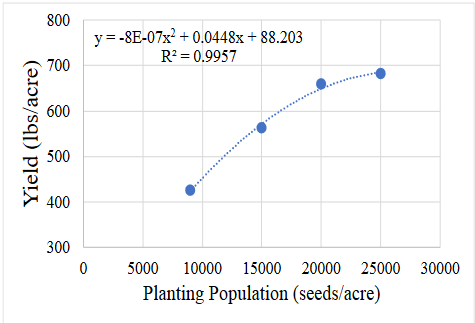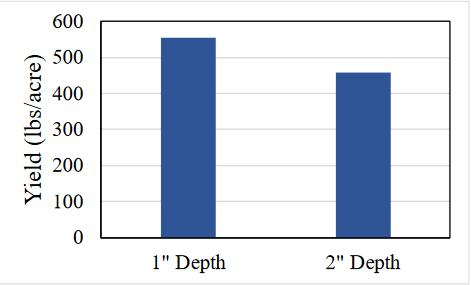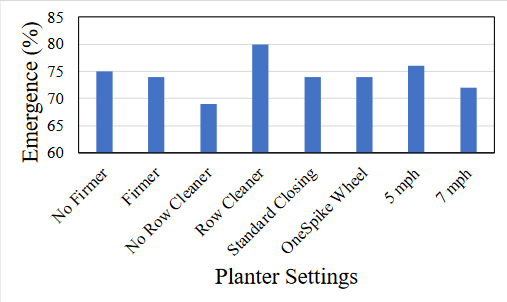Sunflower Planting Depth and Population in the Oklahoma Panhandle
Planting population for different markets and cultivars
Sunflower is a drought tolerant crop produced mainly for two markets: confectionery or oilseed. The quality standards of the seeds produced, specially seed size and oil content, are different for oilseed and confectionery markets. The desired seed size for confectionery production is larger with relatively lower oil content, whereas the qualities desirable for oilseed are smaller seeds with high oil content. Despite different quality parameters, a majority of production practices for these two types are similar. The primary difference comes in the threshold for insect pest damage, where confectionery has a lower threshold compared to oilseed. Many studies at various locations across the US have shown that seeding rate is the major factor which determines the size and oil content of the seed, where high seeding rate tend to produce small seeds with greater oil content, and vice-versa. Because the size of confectionery sunflower seeds is critical for its market values, the crop produced for confectionery seeds is planted at relatively lower population than oilseed production. In addition to different markets, sunflower cultivars can be classified as either standard or dwarf. Standard cultivars are typically taller, with heights reaching up to 6 feet. Dwarf cultivars are typically much shorter, approximately 3 feet, and often will have a less likelihood for lodging. These standard and dwarf cultivars can also influence seeding rates and practices, with the dwarf cultivars typically being planted at higher seeding rates and narrower rows.
According to High Plains Sunflower Production Guide, final sunflower population should be 18,000 to 22,000 plants per acre for oilseed production and 12,000 (dryland) to 18,000 (irrigated) plants per acre for confectionery seed production. A study evaluating 5 different seeding rates of sunflower (RRC 8025 hybrid, confectionery seed) in the Oklahoma panhandle showed improved yield as planting population increased from 9,000 plants per acre to 25,000 plants per acre (Figure 1). However, the amount of yield increase with increasing plant populations diminished at the highest populations. For example, the gain in yield was 32% when population increased from 9,000 to 15,000 seeds per acre, 17% when population increased from 15,000 to 20,000 seeds per acre, and only 3.5% when population increased from 20,000 to 25,000 seeds per acre. However, these yields were not statistically different among different populations.
Seed spacing and depth uniformity
Besides population, the uniformity of plants influences the overall quality and survivability of the crop. Sunflowers require soil temperature of 50oF or above to germinate uniformly. According to Khalifa et al., (2000), ideal temperature for maximum sunflower seed germination rages from 59-77oF. The germination and germination rates decline above 95oF. Data generated by Robinson et al. (1982) showed that uniform and single spaced seed (1 plant per 80cm) will typically result in seed with higher oil content and lower moisture at harvest, compared to unevenly spaced plants. However, it is not only quality that is influenced, uneven spacing can result in up to 31% yield reductions. Plant spacing non-uniformities include large skips or crowded spacing which reduces yield contribution from individual plants. Several factors can contribute to uneven or non-uniform stands, including poor seeding conditions, high planter speed, disease, insect injury or poor quality seed (Kandel et al., 2013).
Differences in planters, planter adjustments and planting practices can play an important role in germination and uniform stands as well. For example, a no-till vacuum planter provided the best uniformity as it was able to obtain best spacing and uniform depth on a no-till sandy clay loam at 18% soil moisture content (Celik et al., 2007). Work from Celik et al. (2007) in sandy clay loam also showed that increase in planter speed only reduced germination time. The data from Oklahoma panhandle show average germination rate ranging from 70-80% for sunflower with different planter settings. This experiment showed that row cleaner had the major impact on emergence, where including a row cleaner improved germination by 11% followed by speed, which improved emergence by 4% when speed reduced from 7 mph to 5 mph. For detailed report on planter impact on germination readers are advised to refer to Celik et al. (2007).
Right planting depth is crucial for uniform germination of crops. In general, recommended planting depth for sunflower production is between 1-2 inches; and planting deeper than 3 inches is highly discouraged. In the Oklahoma panhandle, a trial evaluating planting depth found that planting at 1 inch resulted in higher yields than those of 2 inches, although this was not statistically significant (Figure 2). This could be due to less seed energy being spent to establish the crop at 1 inch. Because more seed energy is spent between germination and emergence with deeper planting depths, less energy is available for early crop establishment.
The results from those studies provided evidence of the impact of planting depth and population on sunflower yields. It should be noted that the results presented in this fact sheet from Oklahoma Panhandle were from a dwarf variety. Another variety planted for yield potential at the same field the same year was RRC 2414 (but not included for depth and population studies), which yielded 1688 (±232) lbs/acre. This variety was planted at 1” depth and was about 6 feet in height. Data from R.F. Meyers’ work in Colorado showed that sunflower yields tend to decline as planting date moves from May to June. The Oklahoma panhandle study was planted in second week of June. Therefore, the lower yields in these experiments could be due to late planting as well as lower germination rate than the above-mentioned studies. It should also be noted that the planter performance may vary with different soil types and planting conditions.

Figure 2. Sunflower yield for 1 and 2 inch planting depth. Error bars represent standard deviation.
Figure 3. Sunflower emergence (%) under different planter settings at Oklahoma Panhandle Research and Extension Center in Goodwell, OK (adopted from: Godsey et al.).
Summary
In summary, we recommend the planting depth of sunflower seeds to be 1 inch. The confectionery seeds production should be planted at 15000 to 20,000 seeds per acre and up to 22000 for oilseed production. The planter speed tends to influence seed germination where 5 mph results in better germination than 7 mph. Therefore, seed depth and spacing should be checked while planting to make sure the depth and population are precise for a given speed.
References
Celik, A., I. Ozturk, T.R. Way. 2007. Effects of various planters on emergence and seed distribution uniformity of sunflower. Applied Engineering in Agriculture (23):57-61. Available at: ResearchGate: Effects of Various Planters on Emergence and Seed Distribution Uniformity of Sunflower
Godsey, C. Planting Decisions for Oklahoma Sunflower Production. Available at: https://www.sunflowernsa.com/uploads/17/godsey_plantingdecisionsoklahoma.pdf
High Plains Sunflower Production Handbook. Colorado State University, Kansas State
University, University of Nebraska, University of Wyoming. Available at: https://bookstore.ksre.ksu.edu/pubs/mf2384.pdf
Kandel, H. 2013. National Sunflower Crop Survey. North Dakota State University Extension
Service. Available at: National Sunflower Association 2013 National Sunflower Crop Survey
Khalifa, F.M., A.A. Schneiter, E.I. ELtayeb. 2000. Temperature - Germination responses
of sunflower (Helianthus annus L.) genotypes. HELIA 23: 97-104 Available at: file:///C:/Users/Sumit/Downloads/10.1515_helia.2000.23.33.97.pdf
Lopez, M.P., A.J. Hall. 2019. Sunflower oil yield responses to plant population and
row spacing: vegetative and reproductive plasticity. Field Crops Research 230:17-30.
National Sunflower Association. High Plains Sunflower Production Handbook. Available
at: https://www.sunflowernsa.com/uploads/3/planting-sunflower.pdf
Smith, J.A., M.F. Kocher. Evaluate planter meter and seed tube systems for seed spacing
performance of confection sunflower seed to improve plant spacing in the field. https://www.sunflowernsa.com/uploads/research/330/Smith_PlanterMeter_08.pdf
Robinson, R.G., H.J. Ford, W.E. Lueschen, D.L. Rabas, D.D. Warnes, and J.V. Wiersma.
1982. Response of sunflower to unfromity of plant spacing. Agronomy Journal 74(2):
363-365.
Warrick, B.E., Sunflower Production Guide. Texas A&M University. Available at: https://sanangelo.tamu.edu/extension/agronomy/agronomy-publications/sunflower-production-guide/


